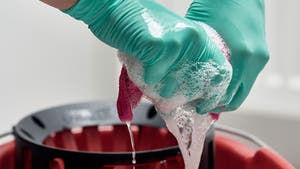The OSHA Emergency Temporary Standard: Ensuring a Compliant Cleaning and Disinfection Program
On January 31, 2020, the US Department of Health and Human Services declared the COVID-19 situation a public health emergency.1 Nearly year and a half later in June 2021, the Occupational Safety and Health Administration (OSHA) issued the COVID-19 Emergency Temporary Standard (ETS) CFR 1910.502.2 The ETS requires employers in all healthcare settings to develop and implement a COVID-19 Plan to identify and control COVID-19 hazards in order to protect workers when treating suspected or confirmed COVID-19 patients This blog post will focus on the cleaning and disinfection requirements of the ETS.
Employers must conduct a hazard assessment of the entire workplace to identify and understand where COVID-19 hazards might exist and what controls must be implemented to minimize the risk of COVID-19 transmission. High risk areas, tasks, and occupations must be identified in the assessment. This includes the identification of high-touch surfaces. Facilities are expected to follow both the CDCs “Guidelines for Environmental Infection Control in Healthcare Facilities” for standard practices for cleaning and disinfection of surfaces and equipment as well as the COVID-specific recommendations found in the CDCs “Interim Infection Prevention and Control Recommendations for Healthcare Personnel During the COVID-19 Pandemic”. The latter guidance calls for the following:
- Equipment that cannot be dedicated to the patient room is to be cleaned and disinfected per manufacturer’s instructions for use (IFUs) between every patient.
- Ensuring that environmental cleaning and disinfection procedures are followed consistently and correctly.
- Use of an EPA-registered disinfectant from EPA’s List N. Appropriate disinfectant formats include ready-to-use sprays, concentrates, and wipes.
- Delay room entry for terminal cleaning until time has elapsed for enough air changes to remove potentially infectious particles. After this time, EVS personnel can enter the room wearing a facemask (for source control) along with a gown and gloves. Eye protection should be added if splashes or sprays during cleaning and disinfection activities are anticipated or otherwise required based on the selected cleaning products.
- No-touch devices (NTDs) can be used as an adjunct to terminal cleaning. UV, electrostatic sprayers, and foggers are examples of NTDs.
Furthermore, the ETS requires that employers have cleaning and disinfecting policies and procedures. The cleaning frequencies to be included in the policies are outlined below:
- High-touch surfaces are to be cleaned at a minimum of least once per day and when visibly soiled. However, I recommend increased frequency for high-touch surfaces to reduce transmission risk of not only COVID-19 but other pathogens as well.
- After an aerosol-generating procedure on a person with suspected or confirmed COVID-19, clean and disinfect the surfaces and equipment in the room or area where the procedure was performed.
- In other areas, when a COVID-19 positive person has been in the workplace within the last 24 hours, clean and disinfect any areas, materials, and equipment that have likely been contaminated.
- Ensure that employees have sufficient time during their work shift to perform the required cleaning and disinfection activities.
To avoid costly citations, you may wish to familiarize yourself with the OSHA Inspection Procedures.3
When will the OSHA ETS end? In all likelihood, when the public health emergency is declared over, the ETS will “end” with the many of the elements being absorbed into other existing OSHA standards such as the general respiratory protection standard.
UPDATE!
On December 27, 2021, OSHA issued a statement that the ETS will remain in effect as they continue to work on a permanent standard, however they have withdrawn the non-record keeping portions of the ETS. In OSHA’s language: “given OSHA’s anticipated finalization of this rule, OSHA strongly encourages all healthcare employers to continue to implement the ETS’s requirements in order to protect employees from a hazard that too often causes death or serious physical harm to employees.” My recommendation in order to avoid confusion with staff (e.g., start-stop-start again) is to continue to follow the ETS as originally written as the elements will, in likelihood, be included in the final rule.
1. U.S. Department of Health and Human Services. Determination that a Public Health Emergency Exists [internet]. [cited 2021 Aug 21]. Available from https://www.phe.gov/emergency/news/healthactions/phe/Pages/2019-nCoV.aspx
2. Occupational Safety and Health Administration. COVID-19 Emergency Temporary Standard. COVID-19 Healthcare ETS [internet]. [cited 2021 Aug 21]. Available from https://www.osha.gov/laws-regs/regulations/standardnumber/1910/1910.502
3. Occupational Safety and Health Administration. Inspection Procedures for the COVID-19 Emergency [internet]. [cited 2021 Aug 21]. Available from https://www.osha.gov/sites/default/files/enforcement/directives/DIR_2021-02_CPL_02.pdf


